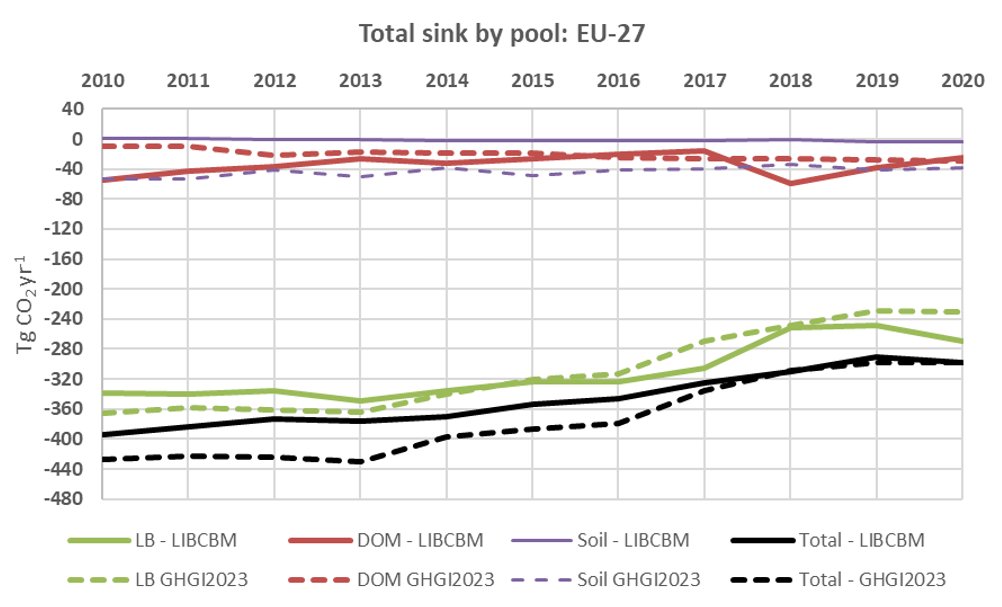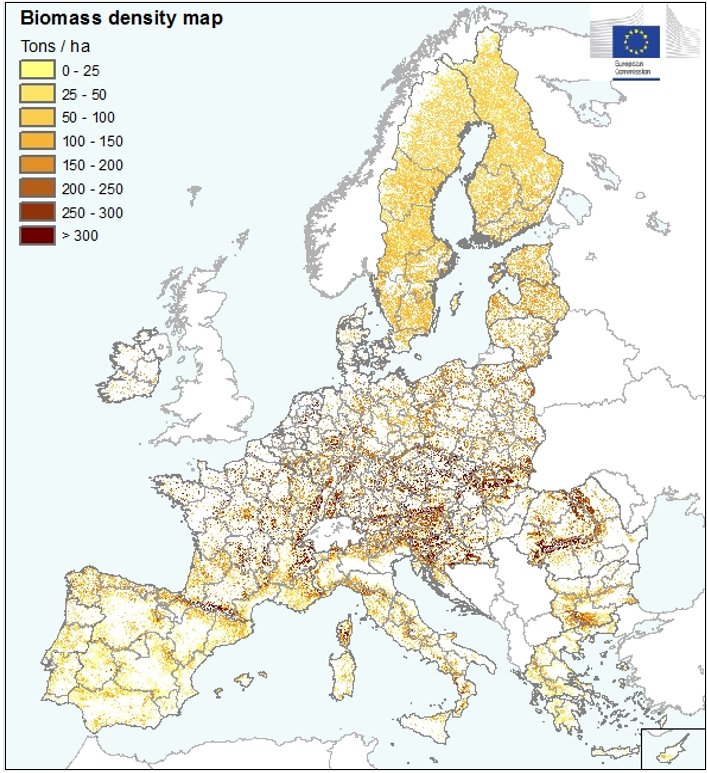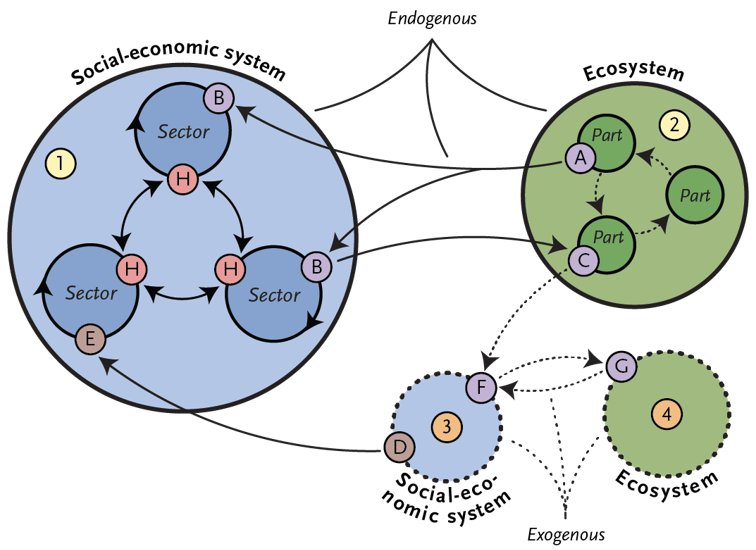We investigate woody biomass flows, including trade, and create models to simulate future scenarios to understand the implications of wood removals through different indicators, including the forest sink. We analyse interactions between forest ecosystems, forest resources and socio-economic processes. Our team of data scientists and forest experts compile and harmonise statistics at EU and EU Member State level in an effort to contribute to monitoring the EU Bioeconomy. Multiple streams of research include mapping of biomass, multifunctionality of forests, forest management, and woody biomass flows assessments under the JRC Biomass Mandate.
Our main specific activities are focused on:
- Woody biomass flows and wood resource balance: analysis of woody biomass flows for European countries.
- Forest modelling: forward-looking assessments accounting for complex interactions between biophysical and economic processes.
- Forest Resource mapping: estimate forest biomass from satellite imagery and Forest Available for Wood Supply (FAWS) across the EU with a harmonized, analytical approach.
- Trade flows, land footprint and deforestation embodied in trade flows: research on the impact of trade flows and European Union consumption of bio-based products on deforestation and forest degradation.
- Integrated bioeconomy land use assessment: Societal metabolic approach to assess European land use through the bioeconomy lens.

Spruce and larch alpine forest. © pasja1000, CC0, pixaby.com.
|
Woody biomass flows and wood resource balance |
|
|
Wood is a highly versatile material and can be used and reused in cascade in different processes. The developments in wood-based product markets are instrumental to the supply of woody biomass for the different purposes.
Biomass flow diagrams (Sankey diagrams) represent in a unique view the flows of biomass of different sectors of the bioeconomy, from supply to uses including trade. Flows are used to illustrate cascade uses, the competition and synergies as well as the importance of different sub-sectors. We publish the woody biomass flows at EU Member State level, as well as at EU-27 aggregate level in the Knowledge Centre for Bioeconomy in interactive web-based diagrams. Within the JRC Biomass Mandate, forest biomass flows are integrated with flows from other bio-based sectors: the agriculture, waste and seafood supply chains.
The Wood Resource Balance is useful in providing an overview over sources and uses of woody biomass, and—most importantly—highlighting data gaps and inconsistencies. As for any balance sheet, the two sides should balance, were all data reported correctly. We publish the wood resource balance sheets at EU Member State level, as well as at EU-27 aggregate level in the Knowledge Centre for Bioeconomy in interactive web-based diagrams. |

Sankey diagram of woody biomass flows in the EU-27 (year 2017). Values are expressed in Mm3 SWE. Source: JRC 2022. |
|
Forest bioeconomy modelling |
|
|
We model the future demand for woody biomass by applying the Global Forest Products Model (GFPMx) (Buongiorno, 2021). On the forest dynamics side, the JRC forest carbon model: EU-CBM-HAT can simulate different scenarios of how the demand for wood can be satisfied. The forest carbon model EU-CBM-HAT (European Union – Carbon Budget Model – Harvest Allocation Tool) enables the assessment of forests CO2 emissions and removals under scenarios of forest management, natural disturbances, forest-related conversions and roundwood destinations (Blujdea et al., 2022). The model works as an integration of two EU specific modules developed by the JRC in collaboration with the Canadian Forest Service (CFS). EU-CBM-HAT is an integration of two EU specific modules developed by the JRC in collaboration with the Canadian Forest Service (CFS) and is available here: the EU-CBM-HAT core package. |

Total C sink estimated by libcbm and reported by EU countries’ GHGI (2023) for the categories FL-FL, L-FL (afforestation) and FL-OL (deforestation), further distinguished between living biomass (LB), dead organic matter (DOM, including DW and litter) and soil (only including mineral soil for GHGI data). GHGI data do not include CY and MT. Source: JRC 2023.. |
|
Forest Resource mapping |
|
|
Forests are becoming increasingly relevant for several forest-related policies in the EU under the Green Deal. The JRC supported dedicated efforts of EU National Forest Inventory (NFI) institutions to make a harmonised assessment of the main restrictions to wood availability and to quantify the forest area and biomass stock not available for wood supply, as well as to achieve more harmonised forest increment statistics. The harmonised forest biomass database for EU-27 and related maps produced by the JRC are available at:
Detailed biomass flows from forestry and the list of related publications are available here: |

Map of forest biomass density (tonnes/ha) matching the harmonised reference statistics for 2020. Source: JRC 2022 (own data). |
|
Trade flows, land footprint and deforestation embodied in trade flows |
|
|
Deforestation and forest degradation, are recognised as important drivers of global warming, the global Carbon cycle, and biodiversity loss. For example, the recent publication "The state of world's forests" from the Food and Agriculture Organization of the United Nations (FAO) (FAO and UNEP, 2020) reported, between 1990 and 2020, 420 million hectares of gross and 178 million hectares of net forest loss. We conduct research to develop methods to monitor production of commodities potentially associated with deforestation and forest degradation, bilateral trade flows of commodities and products between EU-27 and the producing countries (e.g., Rougieux et al., 2023). |

Example of deforestation due to EU-27 import cocoa, coffee, beef, palm oil, and soybeans products. Source: JRC 2022 (own calculation) and modified from Migliavacca et al., 2023). |
|
We also conduct research on the uncertainty of footprint models, with a particular focus on land and biomass footprint, in collaboration with other JRC Units. Finally, we develop methods to calculate the share of deforestation in import and consumption of forest risk commodities (e.g., Bausano et al., 2023; Migliavacca et al., 2023). Our approach is to combine the satellite observation developed by the European Observatory for deforestation and forest degradation (EUFO) with official statistics of production, trade, and land use change. Our tools, such as the biotrade python package, are open source and available at the EUFO webpage or in the main code repositories. |
|
|
Integrated bioeconomy land use assessment |
|
|
Land-based ecosystems in Europe are mostly transformed and, like all other Earth system components, have been substantially impacted through the post-WWII Great Acceleration. Nowadays, EU bioeconomy-related policies may impact land use in different ways depending on their specific objectives and targets. Either they may directly focus on the protection of wilderness and biodiversity conservation, or enhancement of the carbon sequestration potential of land-based processes, or they may indirectly influence land by promoting the use of land-based biomass to reach climate, energy or other economic targets. In even broader terms, EU institutions and policies affect land systems by influencing cultural and social norms, as well as defining the socioeconomic systems in place (e.g. property and ownership structures). Agriculture and food production systems in particular are major drivers of land use. Additionally, in a globalized world, EU consumption patterns largely affect land systems in third countries. We are coordinating a multidisciplinary team to assess land use, including society as a fundamental part of metabolic processes governing production, management and use of biomass. Land systems are therefore broadly framed as social-ecological systems (SES): complex adaptive systems whereby the outcomes of human actions on societies and ecosystems, including policy-driven actions, are intrinsically difficult to anticipate. More on this project on the Knowledge for Policy webpages. |

Conceptual model detailing a social-ecological system with endogenous social-economic system (1) and ecosystem (2) aspects. Also shown are an exogenous social-economic system (3) and ecosystem (4) to represent externalities such as trade. Source: JRC, 2023. |

